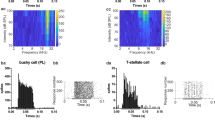Abstract
The auditory pathways of the nervous system consist of specific projections to the auditory cortex and non-specific projections to the reticular formation. Impulses from the reticular formation are transmitted to different areas of the brain and also influence the peripheral autonomic nervous system (Figure 1) (1,2). In this way, acoustic stimulation may influence both auditory and non-auditory processes. This paper reviews the effects of sound (and noise) upon the semsory processes and its use as an audio-analgesic.
Access this chapter
Tax calculation will be finalised at checkout
Purchases are for personal use only
Preview
Unable to display preview. Download preview PDF.
Similar content being viewed by others
References
Anticaglia, J. and A. Cohen, 1970. Extra-auditory effects of noise as a health hazard, Journal of the American Industrial Hygiene Association, in press.
Grandjean, E. Biological effects of noise. Department of Hygiene and Work Physiology, Swiss Federal Institute of Technology, Zurich (undated).
Pressburger, I. and I. Sommer, 1937. Uber die beeinflussung des gesichtsfeld durch labyrinthare reize. Zentralblatt für die Gesamte Ophthalmologica 37:667.
Ogielska, E. and K. Brodziak, 1965. L’influence due bruit sur le champ visuel. Annales d’Occulistiane (Paris) 198:115–122.
Guerrier, Y. et al 1960. Retinite pigmentaire et surdite. Journal Francais d’Oto-Rhino-Laryngologie, Audio-Phorologie et Chirurgie Maxillo-Faciale (Lyon) 8:1025–1035.
Ceroni, T. et al 1958. A study in the vestibular function in patients with chronic simple glaucoma. Rivista Oto-Neuro-Oftalmologica (Bologna) 33:172–194.
Beretta, L. and E. Cerabollini, 1957. The problem of hypoausia in glaucoma. Rivista Oto-Neuro-Oftalmologica (Bologna) 32:662–677.
Vynckier, H., 1967. Surdite professionelle et champ visuel. Acta Oto-Rhino-Laryngologica, Belgica (Bruxelles) 21:213–222.
Kravkov, S., 1936. The influence of sound upon the light and color sensibility of the eye. Acta Ophthalmologica (Kobenhavn) 14:348–360.
Grognot, P. and G. Perdriel, 1959. Influence du bruit sur certaines fonctions visuels. Medicine Aeronautique 14:2 5–30.
Grandpierre, R., Grognot, P., and G. Perdriel, 1965. Le bruit est il nocif pour la vision? Presse Thermale et Climatique (Paris) 120:164–165.
Jansen, G., 1969. Effects of noise on the physiologic state. In: Noise as a public health hazard, American Speech and Hearing Association, Washington, D.C., Report 4:89–98.
Roth, N., 1966. Startling noise and resting retractive state. British Journal of Physiology 23:223–231.
Kishida, H., 1960. Effect of low frequency current on the eyes. Acta Societatis Ophthalmologicae Japonicae (Tokyo) 64:695–700, 1150–1156.
Benko, E., 1959. Objeckt- und farbengesichtsfeldeinengung bei chromischen larmschaden. Ophthalmologica 138:449–456.
Bonaccorsi, P., 1965. Il colore dell’ iride come “test” di valutazione quantitative, nell’ uomo, della concentrazione di melanina nella stria vasculare. Annali di Laringologia, Oto-logia, Rinologia, Faringologia (Torino) 64:725.
Bonaccorsi, P., 1965. Studio comparativo sulla distribuizione della melanina della stria vasculare nella varie spire della coclea umana. Bollettino delle Malattie dell’Orecchio, della Gola, del Naso (Firenze) 83:829.
Bonaccorsi, P., 1963. Comportarnento delle barriere emolabirin-tica, liquorale ed oftalmica nell’ albinismo. Annali di Larin-gologia, Otologia, Rinologia, Faringologia (Torino) 62:432.
Tota, G. and G. Bocci, 1967. L’importanza del colore dell’ iride nella valutazione della resistanza dell’ udito all’ affaticamento. Rivista Oto-Neuro-Oftalmologica (Bologna) 42:183–192.
Levinson, J., 1968. Flicker fusion phenomena. Science 160:21–28.
Besser, G.M., 1967. Some physiological characteristics of auditory flutter fusion in man. Nature 214:17–19.
Hennebert, P., 1960. Nystagmus audiocinetique. Journal of Auditory Research 1:84–89.
Weber, B. and W. Milburn, 1967. The effects of a rhythmically moving auditory stimulus on eye movements in normal young adults. Journal of Auditory Research 7:259–266.
Ades, H.W. et al, 1957. Nystagmus elicited by high intensity sound. Research Project NM 130199, Subtask 2, Report 6, U.S. Navy Research Laboratory, Pensacola, Florida.
Bekesy, G., 1935. Acoustic stimulation of the vestibular apparatus. Archiv für die Gesamte Physiologie 236:59–76.
Dickson, E.D. and D. Chadwick, 1951. Disturbance of equilibrium and other symptoms induced by jet engine noise. Journal of Laryngology and Otology 65:154–165.
Von Gierke, H.E., 1965. On noise and vibration criteria. Archives of Environmental Health 11:327–339.
Lange, G., 1966. The tullio phenomena and possibility for its treatment. Archiv für Klinische und Experimentelle Ohren-, Nasen-und Kelhkopfheilkunde (Berlin) 187:643–649.
Hirsch, I., 1952. The measurement of hearing, McGraw-Hill Book Cp., Inc., New York.
Plutchik, R., 1962. Physiological responses to high intensity intermittent sound. Contract Number NONR-2252 (01), Office of Naval Research, Hofstra College, Hempstead, New York.
Gardner, W. and J. Licklider, 1959. Auditory analgesia in dental operations. Journal of the American Dental Association 59:1144–1149.
Gardner, W., Licklider, J. and A. Weisz, 1960. Suppression of pain by sound. Science 132:32.
Sidney, B., 1962. Audio-analgesia in pediatric practice: A preliminary study. Journal of the American Pediatric Association 7:503–504.
Monsey, H., 1960. Preliminary report of the clinical efficacy of audio-analgesia. Journal of the California Dental Association 36:432–437.
Burt, R. and G. Korn, 1964. Audio-analgesia in obstetrics. American Journal of Obstetrics and Gynecology 88:361–365.
Carlin, S. et al, 1962. Sound stimulation and its effect on dental sensation threshold. Science 138:1258–1259.
Camp, W., Martin, R., and L. Chapman, 1962. Pain threshold discrimination of pain intensity during brief exposure to intense sound. Science 135:788–799.
Robson, J. and H. Davenport, 1962. The effects of white sound and music upon superficial pain threshold. Canadian Anaesthesi-ology Society Journal 9:105–108.
Morosko, T. and F. Simmons, 1966. The effect of audio-analgesia on pain threshold and pain tolerance. Journal of Dental Research 45:1608–1617.
Rosenblith, W., 1968. In: Noise as a public health hazard. American Speech and Hearing Association, Washington, D.C., Report 4:12–17.
Ades, H., 1953. Benox Report, Orientation in space. Office of Naval Research Report 144079, University of Chicago.
McCabe, B. and M. Lawrence, 1958. The effects of intense sound on the non-auditory labyrinth. Acta Oto-Laryngologica (Stockholm) 49:147–157.
Author information
Authors and Affiliations
Editor information
Editors and Affiliations
Rights and permissions
Copyright information
© 1970 Plenum Press, New York
About this chapter
Cite this chapter
Anticaglia, J.R. (1970). Extra-Auditory Effects of Sound on the Special Senses. In: Welch, B.L., Welch, A.S. (eds) Physiological Effects of Noise. Springer, Boston, MA. https://doi.org/10.1007/978-1-4684-8807-4_13
Download citation
DOI: https://doi.org/10.1007/978-1-4684-8807-4_13
Publisher Name: Springer, Boston, MA
Print ISBN: 978-1-4684-8809-8
Online ISBN: 978-1-4684-8807-4
eBook Packages: Springer Book Archive




